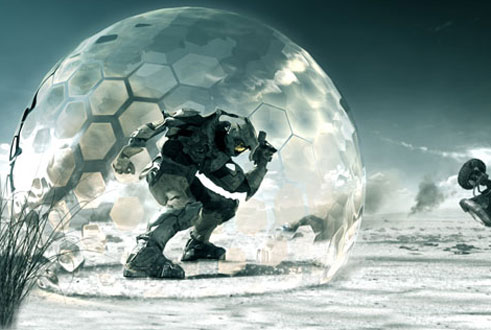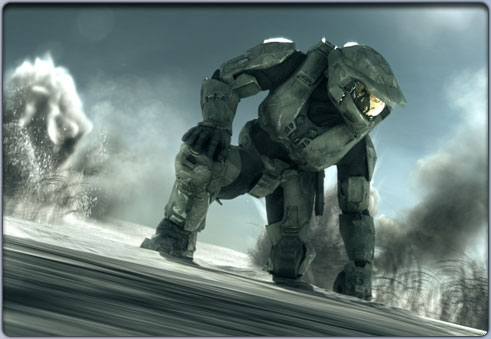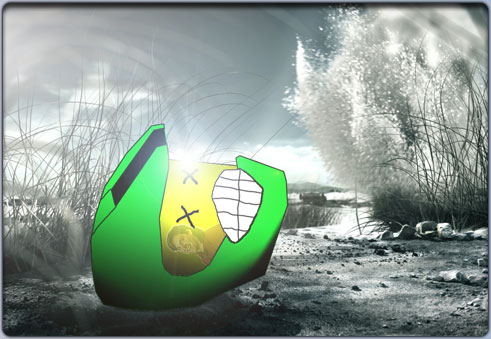Chronique:BWU 08/12/2006
Original[modifier le wikicode]
Posted by Anonymous User (Deleted) at 12/8/2006 3:47 PM PST
A chunky update this week as we talk to Digital Domain, Machine Head and McCann Erickson about what it took to put together last Monday's Halo 3 TV ad, and we chat briefly about the secrets contained in the spot.
Frankie writes:
The funniest thing about the reaction to last week’s TV commercial was probably the oft-repeated claim that the CG on the two kids looked super fake. Which is especially amusing given that the kids, and even the clumps of grass around them, were real. It was all filled with real actors in a real studio. The CG doesn’t begin until you see the Chief’s helmet for the first time.
And of course, in spite of all our attempts to be clear about the content of the commercial, some folks still claimed we were trying to pass it off as gameplay. It was not ever designed to look like gameplay. It was designed to make the Chief look like an unstoppable badass. Mission accomplished!
There was also tons of understandable confusion about the beta. If you go to www.halo3.com, to sign up for the beta, it becomes abundantly clear that it is aimed squarely at US and Canadian residents. Not to worry. This is “phase one” of the beta process. There will be other ways to get into the Halo 3 beta, and it will be open to other countries. We’ll keep you updated as we get more details – such as when you can find out if you’re in the beta, and what t do next. But basically, nothing to worry about.
But on to the matter at hand. The commercial itself. Lots of you wanted to know more, and so, we bring you more. Lots more.
First, we chatted with Ed Ulbrich, the president of Digital Domain’s commercial division.
Bungie: First off, great work Ed, the guys at Bungie were pleased as punch with the final commercial. Can you tell us a little bit about Digital Domain and what the company has achieved in the past?
Ed: As you're probably aware, Digital Domain is an award-winning, full-service digital studio and creates SPX and other visual imagery for feature films, commercials and music videos. As a pioneer in digital effects, our business units have been recognized with top industry awards, including five Academy Awards(r), multiple BAFTA awards, numerous advertising honors including 34 Clio Awards and 8 Cannes Lion Awards, and our work has even earned MTV's Music Video of the Year Award and a Grammy.
Since our beginnings in 1993, we've worked to create next generation technology and truly innovative approaches to extend the boundaries of visual effects to create seamless environments, whether it's creating the 1945 reality of sands and seas of Iwo Jima (including the thousands of troops and ships involved in the battle), as in our current work in the film Flags of our Fathers, or the impact of a new ice age in The Day After Tomorrow.
As you might not know, Digital Domain has made several extremely strategic moves over the last year to grow into new and pretty exciting areas. The company was acquired in May of this year by Wyndcrest Holdings, which includes director Michael Bay as a member. As one of the world's most successful action directors (Bad Boys, The Rock, Armageddon, Pearl Harbor and Bad Boys II), Michael understands visual excitement and how to take action to the next level. We've also hired three top executives in our industry, Mark Miller, Cliff Plumer and Kim Libreri who most recently worked with Industrial Light and Magic, who have a shared vision for convergence of media and technology that we believe can really take our industry to the next level.
Bungie: What kind of assets did Bungie supply you with for the commercial CG?
Ed: Bungie was extremely open and helpful to us. They literally opened up the studio to us and gave us an amazing view into their upcoming game, Halo 3. From the start, Bungie wanted us to give their fans a new and unique visual experience for the Halo Universe. To accomplish this, Bungie supplied us with all their models, textures, and game footage, for all of the characters, weapons, and vehicles seen in this commercial. With these files from Bungie as reference, we modeled, textured, and animated these assets to fit the demanding needs of this spot.
Bungie: What software and processes do you use to turn those assets into a CG movie?
Ed: We began with modeling Master Chief and all of the other assets you see in the spot in Maya and Lightwave. We then textured them in Deep Paint and Photoshop. After that, matte paintings of all the skies, mountains, and select terrain were done in Photoshop. We then started the animation process. For the effect we wanted, we started with motion capture that Joseph Kosinski directed. Then, based on our needs, we key framed on top of it in Maya. All of that was then pushed into lighting. We split this duty between Max/Vray and Lightwave for the characters and terrain. We used Houdini to create fx elements like the sand explosions and blue mortars, and Lightwave for the flowing grass. When all of these things were ready, we composited it into a final image using our in-house compositing software, Nuke and Autodesk's Flame.
Bungie: How did you feel about working with someone else's models and IP, and the Halo franchise generally?
Ed: Sometimes it can be difficult working with someone else's IP, but in this instance that wasn't the case. Bungie had everything together, allowing us access to really top quality models, textures and footage, and worked very, very closely with us. One of the great experiences of this project was that everyone pulled together with the common vision of creating an end product that is truly spectacular.
Bungie: What kind of similarities do you see between game production and movie-style CG creation?
Ed: For us, there's really no difference in creating visuals for games, feature films or commercials - we're in the business of making a vision real, whether it belongs to a developer or director. At Digital Domain, we're very much focused on convergence - it's something that we have been talking about for some time and we're now beginning to see it come together. Our belief is that as we create digital assets, there is an ability to easily repurpose those assets for features from games or games from features - allowing games and features to each have extremely high production values and an extremely realistic look and feel.
We've begun using in-game engines and assets to render gaming commercials - with this approach, we can provide an accurate depiction of actual game visuals and game play, because we're using actual game assets in our commercial development. And we feel that this technique may open up a new genre of feature and/or game-related films that are built in realtime engines. This kind of digital asset sharing and convergence in production really is the wave of the future, and cross development will begin to blur the lines of effects being created for features or games.
Bungie: What was the most challenging aspect of creating Starry Night?
Ed: Basically, it was time. Bungie, Microsoft, McCann Worldgroup, and Digital Domain wanted to create an unforgettable "bridge" spot in the Halo Universe. A filmic look at what Master Chief has been through in the last two games and where he is going in Halo 3. And we all needed to do it in less than five weeks! I must say, the best thing about this commercial for me, was watching everyone at Bungie, Microsoft, McCann Worldgroup, and Digital Domain pull together and giving more than they had to make this event happen. I'll never forget that.
Bungie: What are you guys working on after this?
Ed: We do have several revolutionary projects that we expect will open a few eyes. We've finished a series of commercials that will launch in January that take virtual humans to the next level. We're also working on two major features that use this technology to do things that haven't been seen in visual effects. It's all part of a substantial and ongoing R+D effort we've undertaken to make tremendous advancements in this space and bring more realistic characters to gaming. And, we are in discussions for the first converged film project with shared assets for gaming, so we do have some pretty exciting times in the months ahead.

Next up was audio. Lots of folks have remarked on the lovely audio design in the spot, from the screaming explosion midway through, to the stirring Marty music in the end. Now the music is all Marty, but the sound effects were by Machine Head, and we chatted with Stephen Dewey, the Sound Designer and founder of machine head.
Bungie: Although the music is by our own Marty O'Donnell, you guys did the very interesting audio design. Can you tell us what inspired you and how that process worked? (Machine Head)
Stephen: I was inspired from the first instant of seeing this spot. For me, creating sounds that are futuristic, that have an 'I have not heard that before quality' yet are plausible to events and objects that are familiar to us humans in 2006 is the most fun I could have. This short film has an abundance of opportunities for all the things I love to do, voice manipulation, the juxtaposition of tiny sound filigree to enormous explosions, fantasy devices, good solid foley and enough time to show it all off. The process was fantastic, everyone involved was very supportive and collaborative, special thanks to Joseph Kosinski, the director and all from the agency who allowed me to run off into my sound playground. I was given some initial broad direction, then after I had made my first pass of interpreting what I saw on the screen into the sound realm, there followed a series of sit downs with Joseph and the agency team, experimenting and refining the elements of the soundtrack.
Late nights, rule breaking. Sound pranks. Kudos to Marty too for coming up with a musical score that mapped the emotional curve without bombastically overpowering the soundtrack, and to Jeff Payne for getting all the sounds to sit so well with each other in the mix.

And last, but not least – we chatted with the ad agency responsible for the entirety of the project - McCann Erickson SF’s Group Creative Director, Scott Duchon.
Bungie: What was the inspiration behind the theme of the commercial?
Scott: The inspiration for the commercial came from us wanting to do something that would resonate with the Halo Nation as well as someone who only has a passing knowledge of the Halo franchise. But the idea to show a young child and then jarringly switch to a battle weary soldier came from Tim Stier. By day he's an Art Director at McCann Worldgroup, SF, by night he's a Halo fanatic. We felt this misdirect would allow for people who had no idea who Master Chief was to be able to connect with a more human side of this war, and the Master Chief’s plight, while the Halo Nation would relish the idea of seeing what goes on in the heat of battle.
Matt Priestley, currently hard at work on the ever-more impressive looking Halo 2 for Windows Vista, wanted to chime in with a quick update about the project:
We know some of you want to hear more about the online plans for Halo 2 on Windows Vista. Microsoft will soon have a lot more to say about the Live gaming and entertainment network on Windows, but what we can tell you now is that you’ll be able to play H2V online and even interact with your friends on the Xbox 360 at zero cost (although Halo 2 doesn’t support cross-platform multiplayer). Now that said, there are going to be some very tempting reasons for you to upgrade to a full paid Live Gold membership. We’re sure you want to know more, but you’ll just have to wait until Microsoft is ready to spill the beans.
Finally, it wouldn’t be an update without a suitably themed Mr. Chief. This one is full of secret.
PS, happy birthday to Mat’s Mom. We know you went through hell. Thanks for gifting him to us, by the way. Class move.

Note: Wacky kids have already made YouTube mashups of the commercial with inappropriate, MA-rated music tracks. We do not approve of this kind of malarkey.